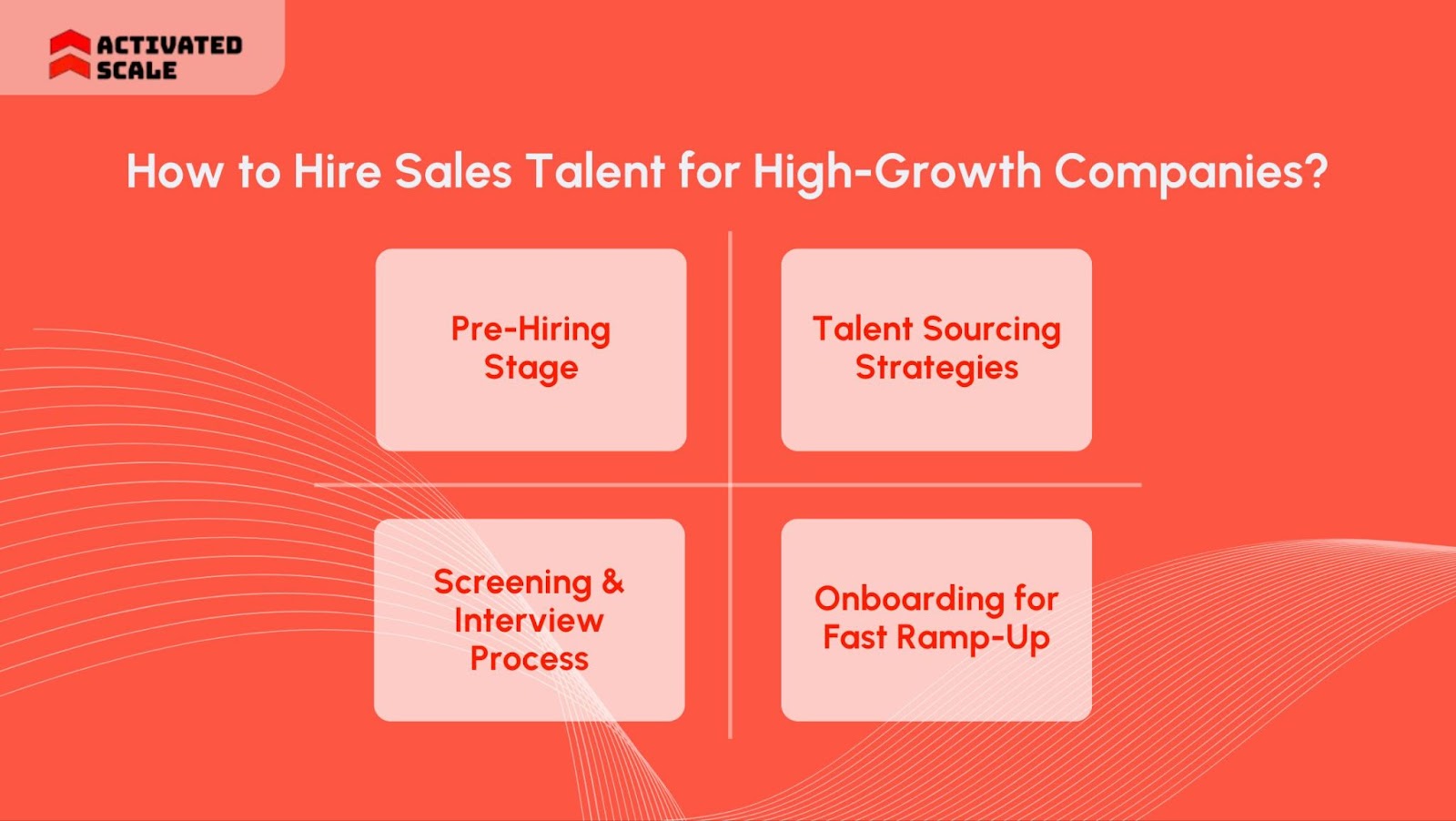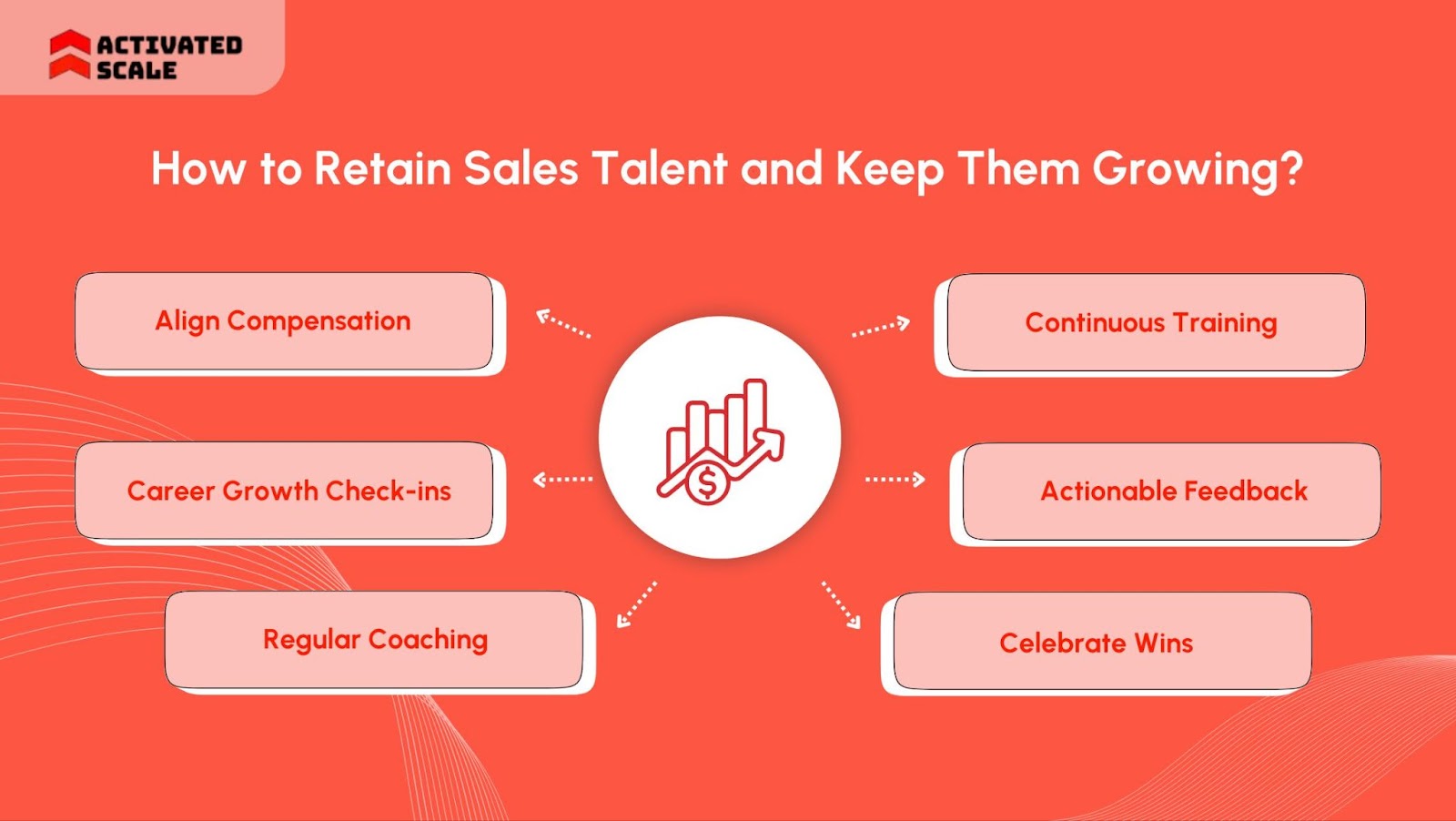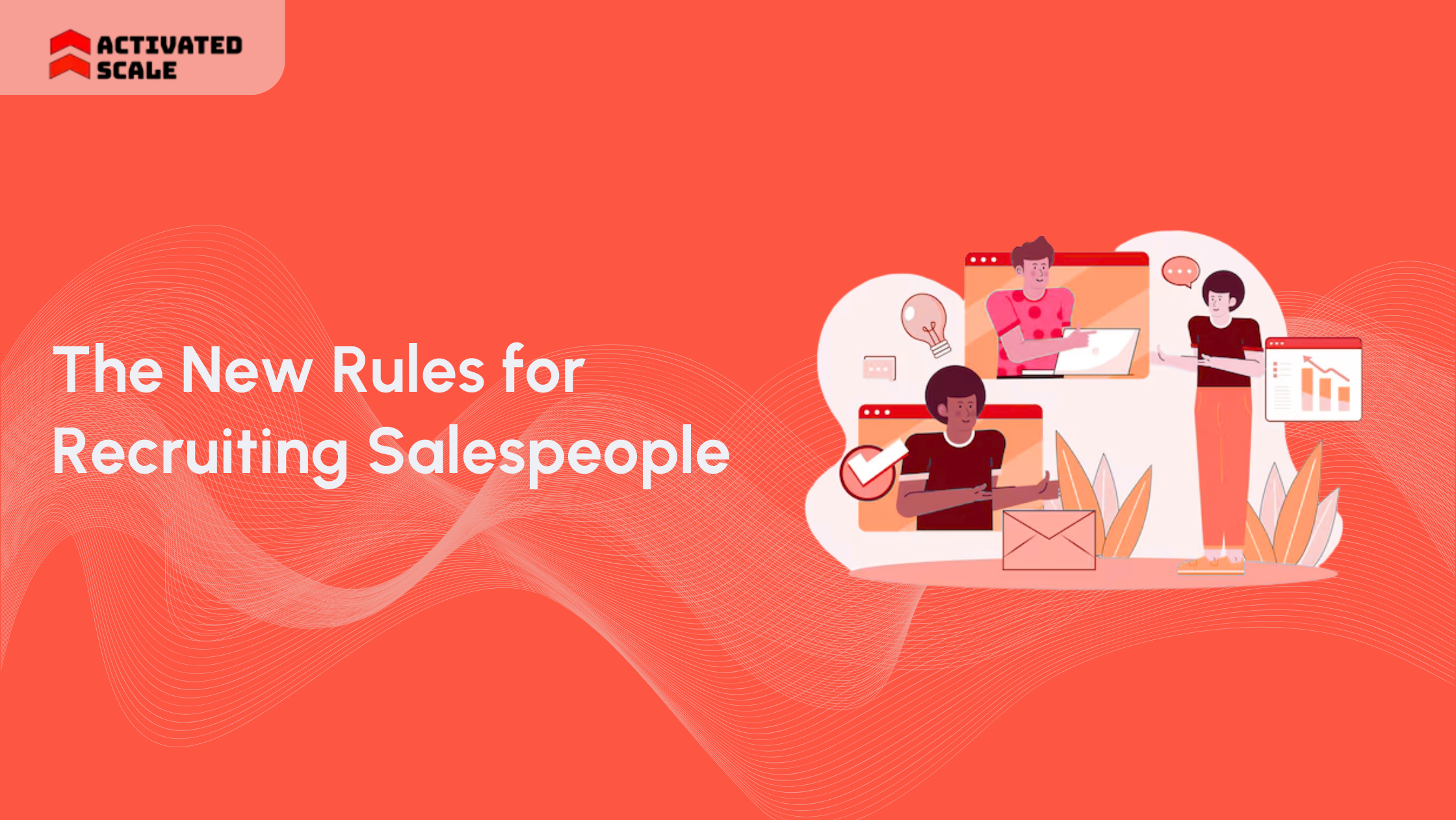Hiring sales talent isn’t just harder now, it’s also more expensive. The average cost to hire a rep in SaaS is too high, and many still churn within the first year. This churn in sales roles costs U.S. businesses $136 billion annually.
Sales leaders in high-growth companies face pressure to scale revenue quickly. However, many leaders waste time chasing talent that looks good on paper but never ramps up.
After working with dozens of fast-scaling B2B teams, we understand what keeps revenue leaders up at night. In this blog, we’ll discuss practical strategies, so you’ll learn how to hire sales talent for high-growth companies.
We’ll also break down each phase of the sales hiring journey so you can keep your top talent for the long haul.
TL;DR
- Hiring for potential without structure leads to costly churn, so build a repeatable sales hiring process early.
- Compensation, onboarding, and coaching matter as much as sourcing, and retention starts before the offer letter.
- Don’t scale blindly. Hire sales talent that fits your stage, not just your dream org chart.
- Great onboarding should involve a 30-60-90 plan that aligns ramp with impact.
- Activated Scale helps you test talent before hiring and fill urgent pipeline gaps fast.
What Defines Top Sales Talent Today?
Every resume sounds strong. However, few sales representatives can consistently deliver results in high-growth environments.
The best teams begin by defining what “great” looks like. These include role-specific traits, like curiosity for sales development representatives (SDRs) or deal strategy for account executives (AEs).
That’s why high-growth companies should hire based on learning agility and early traction, not just domain expertise. That’s especially essential when reps are selling a new category or an unfamiliar product.
That clarity around what defines top talent is your anchor. So, you need a system to attract and assess them before your competitors do. Let’s break down how to build that system, starting with strategic planning.
Also Read: Sales Leader Essentials: Definition, Skills, and Advancing Your Career
How to Hire Sales Talent for High-Growth Companies?

Most companies rush to fill sales roles. They skip strategy, hire reactively, and end up restarting the process three months later. That costs money and team morale.
A bad hire can cost you 30% of an individual’s annual salary. That’s why the right process should filter for quality, not just quantity. Here’s how scaling teams win at hiring:
Step 1: Pre-Hiring Stage
Before sourcing candidates, high-growth teams need to slow down and think through what they actually need.
Here’s what smart teams do before posting a single job:
- Clarify the role and outcomes. Is this hire focused on pipeline generation, mid-market closing, or enterprise expansion? Write those goals down.
- Create a success profile. Define the core traits, skills, and behaviors that align with your company’s sales motion.
- Set compensation based on market data. Tools like Pave or OpenComp help benchmark realistic offers for your stage.
- Choose your hiring model. Not all companies need a full-time rep on day one. Many use fractional AEs or SDRs to reduce risk and test market-fit.
Looking to move fast without overcommitting? Activated Scale’s Fractional Selling Service helps you hire fractional SDRs and AEs who can start selling in days. Test performance before scaling your team.
- Align internally. Hiring without cross-functional input leads to confusion later. Make sure founders, RevOps, and frontline managers are on the same page.
Step 2: Talent Sourcing Strategies
Many sales leaders struggle here. Fast-growing startups need smarter sourcing, not just more applicants.
Top reps rarely apply to job boards. They’re already working, often thriving, and not browsing LinkedIn daily. Reaching them takes a mix of targeted outreach and strong messaging.
Here’s how successful teams build quality pipelines:
- Use warm referrals first. Your best hires often come through existing reps, customers, or advisors. Offer referral bonuses to speed things up.
- Personalize outbound sourcing. Don’t send mass e-mails. Since 73% of people prefer personalized e-mail, reference something relevant, like a company they scaled with.
- Build your employer brand. Candidates search your name before responding. Publish wins, share rep success stories, and update your careers page.
- Focus on mission-aligned communities. Utilize niche communities like Bravado, Sales Hacker, and Pavilion, where top representatives discuss best practices.
- Don’t ignore passive candidates. Many great reps aren’t “looking,” but they’ll move for the right pitch, role, and manager.
Need help reaching proven sales talent who aren't on job boards? Activated Scale sources pre-vetted, high-performing reps through targeted outreach and curated networks. Book a call to see our candidate pool in action.
Step 3: Screening & Interview Process
Most hiring teams rely on resume buzzwords. That’s why so many reps don’t ramp, or worse, they don’t last. A good screening process reduces guesswork and flags red flags early.
Sales interviews should test what matters most: coachability, thinking speed, deal strategy, and motivation.
To hire sales talent for sales-led growth companies, use a structured process like this:
- Start with a phone screen. Don’t over-index on polish. Look for curiosity, clarity, and energy. Can they explain what they sell and how?
- Use a live roleplay. Give them your ideal customer profile (ICP) and ask for a cold call or discovery scenario. You’ll learn more in 10 minutes than a resume ever reveals.
- Ask behavior-based questions. “Tell me about a deal you saved” shows more than “How do you close?”
- Introduce a written task. Ask for a short email sequence or discovery prep doc. Writing reveals thought process and preparation.
- Get multiple perspectives. Use scorecards so team feedback stays focused and consistent.
Note that top interviewers test not just skills, but also how representatives think on their feet. That insight is critical when every month counts.
Step 4: Onboarding for Fast Ramp-Up
Hiring a strong rep means nothing if they don’t ramp quickly. Many startups lose months and deals, because they delay training or skip structure.
The best teams treat onboarding like a sales process. It has a plan, clear milestones, and ongoing check-ins. New hires shouldn't guess how to win.
To onboard right, follow these principles:
- Set a 30-60-90 day plan. Break it into weekly goals. Cover product, ICP, messaging, and process in tight blocks.
Days 1–30: Learn and Observe
Goal: Understand the company, product, and customer. Lay the groundwork.
- Complete product training (internal docs, demos, recorded calls)
- Interview ICP, buyer personas, and value props
- Shadow top-performing reps on live calls
- Review sales collateral, pitch decks, and objection handling guides
- Learn the sales process inside your CRM
- Schedule a weekly 1:1 with your manager
- Book mock calls or internal pitch sessions
Checkpoint: Deliver internal pitch, pass product/ICP quiz, show readiness to begin outreach.
Days 31–60: Execute and Iterate
Goal: Start selling. Focus on quality activity and feedback loops.
- Begin outbound outreach (emails, cold calls, social touches)
- Run discovery calls with manager or mentor shadowing
- Start building a personal pipeline
- Get detailed feedback from every call (call recordings or live)
- Refine talk track and email copy based on live performance
Checkpoint: Hit activity targets (calls, meetings), close first deal, or book X demos.
Days 61–90: Own and Scale
Goal: Operate independently. Build consistency.
- Own full cycle (if AE) or full outbound workflow (if SDR)
- Manage pipeline, update customer relationship management (CRM), and self-source new leads
- Contribute to peer learning: share a win, call breakdown, or objection handling tip
- Set goals for next quarter based on strengths/areas to improve
- Join cross-functional meetings to deepen customer understanding
Checkpoint: Hit 80–100% of quota or activity goal.
- Start before Day 1. Share resources early. Give reps access to your sales deck, call recordings, and CRM structure.
- Pair with a mentor. Peer shadowing shortens ramp and builds trust. Don’t wait to introduce your top performers.
- Use call reviews. Feedback sessions turn fast into faster. Let reps hear what “good” sounds like from Day 1.
- Track early wins. Celebrate quick progress, booked meetings, first demo, and clean CRM updates. Momentum builds confidence.
Startups don’t have time to wait six months for productivity. Onboarding should accelerate success, not just check boxes.
Need fast results from day one? With Activated Scale’s Fractional Sales Leadership, you get experienced SDRs and AEs who come ready to sell. Hire trained reps who’ve done it before.
Fast onboarding gets your reps in motion. However, keeping them engaged is a different challenge. Retention starts the moment they join, not when they think about leaving.
Read Also: Hire Sales People for Your Startup
How to Retain Sales Talent and Keep Them Growing?

Hiring well matters. However, too many companies lose top reps because they stop investing in them after the first few months.
Here’s what top-performing teams do to keep reps engaged and growing:
- Align compensation with real motivation. Great reps are driven by more than quota. Offer accelerators, equity, and clear bonus paths tied to outcomes they control. Your compensation plan should reflect your brand’s intention to hire the best talent.
- Check in on career growth. Don’t wait for annual reviews. Ask where they want to go and what they want to learn, then help them get there.
- Coach regularly. Skip the “numbers only” meetings. Use real calls and real deals to guide them forward.
- Offer continuous enablement. Give access to updated training, buyer insights, and sales tools.
- Give actionable feedback, often. Don’t wait for things to go wrong. Reps need real-time input to improve and feel supported.
- Celebrate smart wins. Public recognition, like call-of-the-week or creative prospecting, boosts morale and team standards.
Retention is key to how you hire sales talent for fast-growing companies, because turnover will kill your momentum. That’s where Activated Scale helps teams build a sales team that lasts.
How Activated Scale Can Help You Hire Top Talents?
We, at Activated Scale, don’t just help you figure out how to hire sales talent for high-growth companies. We stay right there even if the hired talent doesn’t match your expectations. If you aren't satisfied with your salesperson, we can match you with someone new from our network at no cost.
Here’s how we help with our different services:
- Contract-to-Hire Sales Recruiting: No more struggle with cultural misfits. This model allows you to work with vetted sales talent on a trial basis. In this way, you can avoid expensive wrong calls.
- Fractional Selling: Need pipeline coverage while you hire or ramp a new team? Get access to experienced SDRs and AEs who know how to close without committing to long onboarding cycles.
- Fractional Sales Leadership: If you’re scaling fast but lack a sales leader, we plug that gap. Our fractional vice presidents (VPs) of sales help you design your hiring process, so reps stay longer.
Most sales teams fail from hiring the wrong people, at the wrong time, with no clear plan. Activated Scale helps fix that.
Wrapping It Up
Even the best product fails without the right people selling it. Without the right salespeople, you’re just leaving revenue on the table. You’re giving it away.
Sales talent drives the pipeline, shapes customer experience, and turns strategy into traction. That’s why high-growth companies work with Activated Scale, where hiring strategically is an advantage.
Looking to scale with confidence? Book a call and see how Activated Scale helps companies hire sales talent that sticks and sells.
FAQs
1. What traits should I prioritize when hiring sales reps for a startup?
Look for adaptability, resilience, and previous success in similar-stage companies. Prior experience in early-stage sales motions matters more than brand logos.
2. How do I make sure a rep will stay beyond 6–12 months?
Retention starts during hiring. Set clear expectations, align on career path, and involve reps in early-stage decisions. Pair that with structured onboarding and growth check-ins.
3. Should I hire a senior rep or build with juniors first?
It depends on your stage. Early on, a senior AE with builder instincts is key. If your sales process is defined, building a small team of SDRs who work in sync can scale more effectively.
4. How do I compete with bigger brands for top talent?
Differentiate with speed, transparency, and growth opportunity. A defined comp plan and clear runway to impact often beat a big-name logo.
The Ultimate Guide to Hiring a Salesperson!
Get the step-by-step guide to hiring, onboarding, and ensuring success!
_edi.png)




